Serving 489 students in grades Prekindergarten-6, Pope Elementary School ranks in the bottom 50% of all schools in Texas for overall test scores (math proficiency is bottom 50%, and reading proficiency is bottom 50%).
The percentage of students achieving proficiency in math is 28% (which is lower than the Texas state average of 41%). The percentage of students achieving proficiency in reading/language arts is 40% (which is lower than the Texas state average of 51%).
The student:teacher ratio of 14:1 is equal to the Texas state level of 14:1.
Minority enrollment is 81% of the student body (majority Hispanic), which is higher than the Texas state average of 75% (majority Hispanic).
Quick Stats (2025)
- Grades: Prekindergarten-6
- Enrollment: 489 students
- Student:Teacher Ratio: 14:1
- Minority Enrollment: 81%
- Overall Testing Rank: Bottom 50% in TX
- Math Proficiency: 28% (Btm 50%)
- Reading Proficiency: 40% (Btm 50%)
- Science Proficiency: 15-19% (Btm 50%)
- Source: National Center for Education Statistics (NCES), TX Dept. of Education
Top Rankings
Pope Elementary School ranks among the top 20% of public schools in Texas for:
Category
Attribute
Diversity
School Overview
Pope Elementary School's student population of 489 students has stayed relatively flat over five school years.
The teacher population of 35 teachers has grown by 6% over five school years.
Grades Offered
Grades Prekindergarten-6
Total Students
489 students
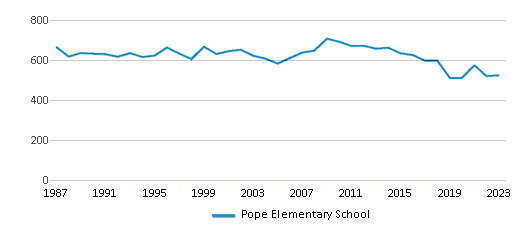
Gender %
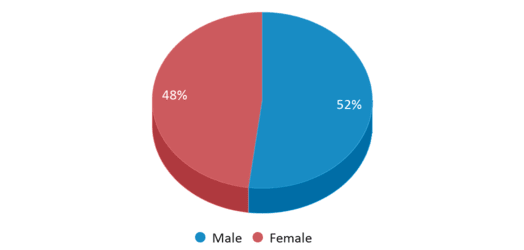
Total Classroom Teachers
35 teachers
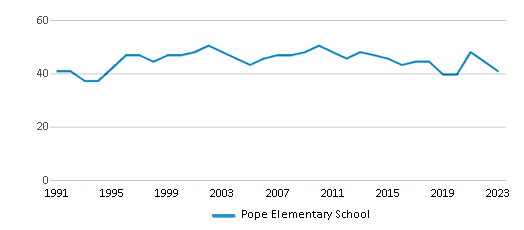
Students by Grade
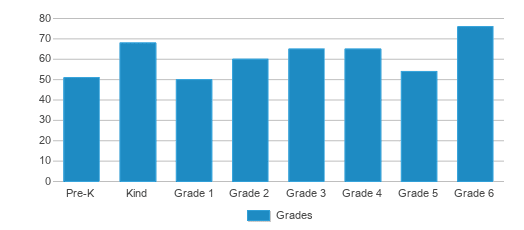
School Rankings
Pope Elementary School ranks within the bottom 50% of all 8,188 schools in Texas (based off of combined math and reading proficiency testing data).
The diversity score of Pope Elementary School is 0.64, which is equal to the diversity score at state average of 0.64. The school's diversity has stayed relatively flat over five school years.
Overall Testing Rank
#6311 out of 8188 schools
(Bottom 50%)
(Bottom 50%)

Math Test Scores (% Proficient)
28%
41%
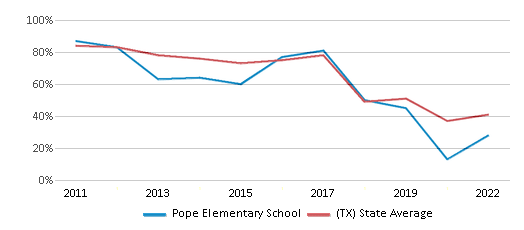
Reading/Language Arts Test Scores (% Proficient)
40%
51%
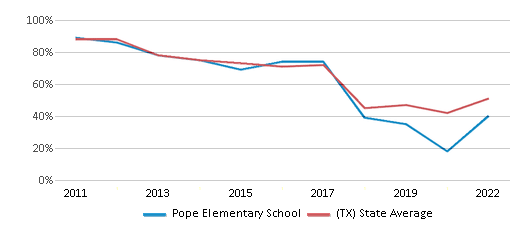
Science Test Scores (% Proficient)
15-19%
46%
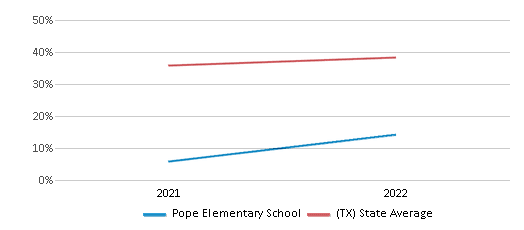
Student : Teacher Ratio
14:1
14:1
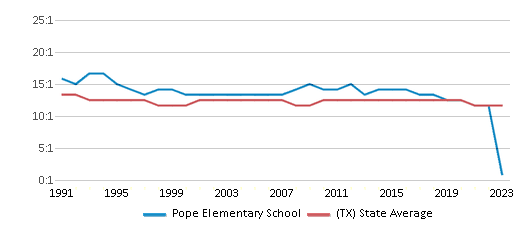
American Indian
n/a
n/a
Asian
1%
6%
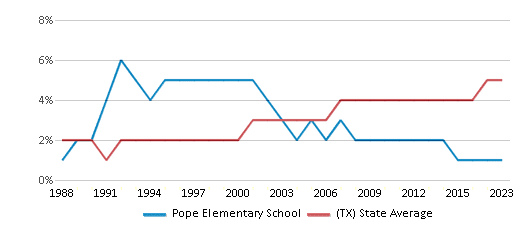
Hispanic
52%
53%
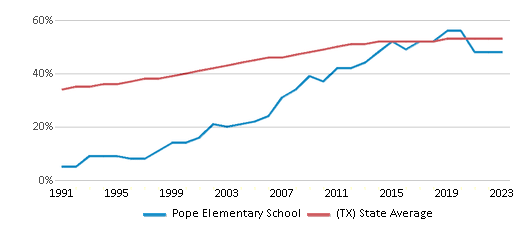
Black
24%
13%

White
19%
25%
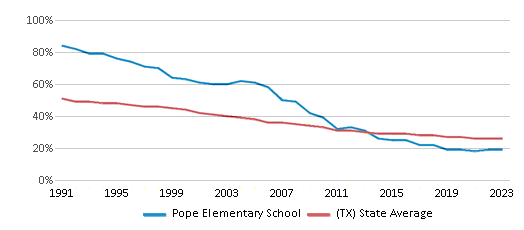
Hawaiian
n/a
n/a
Two or more races
4%
3%
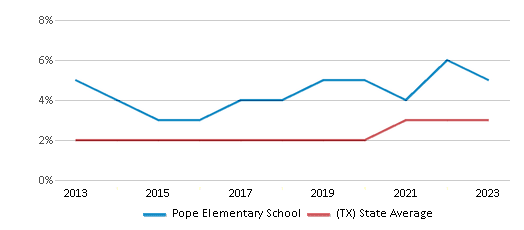
All Ethnic Groups
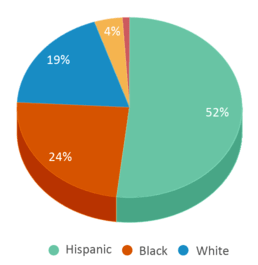
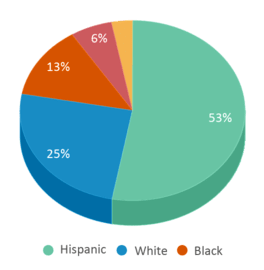
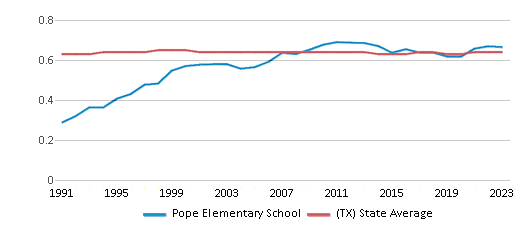
Participates in the National School Lunch Program (NSLP)
Yes
Eligible for Free Lunch
78%
57%
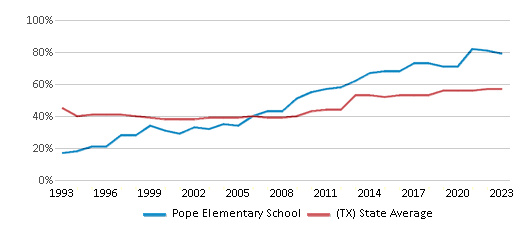
Eligible for Reduced Lunch
3%
5%
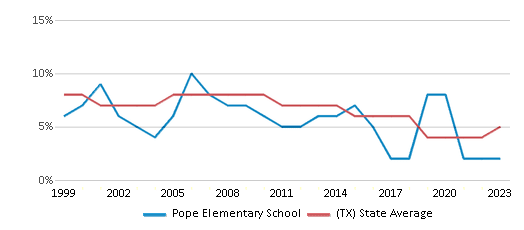
School Statewide Testing
School District Name
Source: National Center for Education Statistics (NCES), TX Dept. of Education
Profile last updated: 02/09/2025
Frequently Asked Questions
What is Pope Elementary School's ranking?
Pope Elementary School is ranked #6311 out of 8,188 schools, which ranks it among the bottom 50% of public schools in Texas.
What schools are Pope Elementary School often compared to?
Pope Elementary Schoolis often viewed alongside schools like Butler Elementary School by visitors of our site.
What percent of students have achieved state testing proficiency in math and reading?
28% of students have achieved math proficiency (compared to the 41% TX state average), while 40% of students have achieved reading proficiency (compared to the 51% TX state average).
How many students attend Pope Elementary School?
489 students attend Pope Elementary School.
What is the racial composition of the student body?
52% of Pope Elementary School students are Hispanic, 24% of students are Black, 19% of students are White, 4% of students are Two or more races, and 1% of students are Asian.
What is the student:teacher ratio of Pope Elementary School?
Pope Elementary School has a student ration of 14:1, which is equal to the Texas state average of 14:1.
What grades does Pope Elementary School offer ?
Pope Elementary School offers enrollment in grades Prekindergarten-6
What school district is Pope Elementary School part of?
Pope Elementary School is part of Arlington Independent School District.
In what neighborhood is Pope Elementary School located?
Pope Elementary School is located in the West Arlington neighborhood of Arlington, TX. There are 16 other public schools located in West Arlington.
School Reviews
5 9/26/2007
Pope is an excellent school. My children all had fantastic teachers who cared about them and helped to build self esteem, with the exception of one third grade teacher who makes every child feel like they behave poorly. I wish an advanced academic program were offered from kindergarten up. Pope offers and advanced math class starting in 3rd grade, and advanced Language Arts beginning in 4th grade, I felt my children would have benefited from advanced learning much earlier. There is a great deal of parental involvement at Pope, any parent can feel involved and needed. The PE, art and music classes are wonderful and well balanced with the academic program. In 5th grade a child in advanced classes can expect an average of 3 hours of homework, too much in my opinion for that age, yet the children don't know any different and they do it anyway.
Review Pope Elementary School. Reviews should be a few sentences in length. Please include any comments on:
- Quality of academic programs, teachers, and facilities
- Availability of music, art, sports and other extracurricular activities
Recent Articles

What Is A Charter School?
Explore the world of charter schools in this comprehensive guide. Learn about their history, how they operate, and the pros and cons of this educational innovation. Discover key facts about charter schools, including admission policies, demographics, and funding, as well as what to look for when considering a charter school for your child.

10 Reasons Why High School Sports Benefit Students
Discover the 10 compelling reasons why high school sports are beneficial for students. This comprehensive article explores how athletics enhance academic performance, foster personal growth, and develop crucial life skills. From improved fitness and time management to leadership development and community representation, learn why participating in high school sports can be a game-changer for students' overall success and well-being.

February 05, 2025
Understanding the U.S. Department of Education: Structure, Impact, and EvolutionWe explore how the Department of Education shapes American education, from its cabinet-level leadership to its impact on millions of students, written for general audiences seeking clarity on this vital institution.





